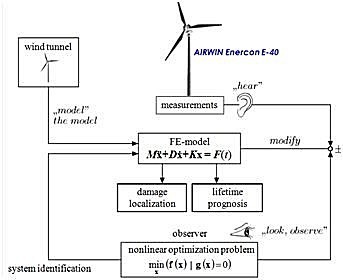Life Cycle Management
Momentanes Haupt-Forschungsgebiet ist das Monitoring, die Systemidentifikation und die Modelladaption für das Life Cycle Management in den Bauingenieur- und Umweltwissenschaften.
Hierzu einige kurze Anmerkungen!
In Deutsch:
Im modernen Ingenieurwesen kommt dem Life Cycle Management bzw. der lebensdauerorientierten Gestaltung von Systemen und Prozessen eine immer größere Bedeutung zu, da hiermit Ganzheitlichkeitsanforderungen erfüllt werden können und eine neue ingenieurwissenschaftliche Qualität ermöglicht wird. Durch kontinuierliches, auf moderner Sensorik basierendes Monitoring, durch – aufgrund von Systemveränderungen erforderlich werdende – Systemidentifikation und anschließende Modelladaption lassen sich verbesserte, mehrstufig konzipierte Simulationsmodelle entwickeln. Diese Modelle weisen dabei eine bisher nicht gekannte Realitätsschärfe auf; sie sind insbesondere in der Lage, Entwurfs- und Konstruktionsentscheidungen, aber auch Eingriffe in das Betriebsverhalten über Langzeiten hinweg oder zum Ende der Nutzungsdauer eines technischen System vorausschauend zu erfassen bzw. gezielt zu beeinflussen. Die Lösung von Nichtstandard-Optimierungsproblemen, die durch Transformation verschiedener Ingenieurprobleme (z.B. Entwurfs-/Auslegungsproblem oder Defektminimierung) in gleichwertige Optimierungsprobleme entstehen, ist dabei Dreh- und Angelpunkt für die numerische Bewältigung der Modellbildung. Mehr...
In English:
Life cycle management of engineering systems and processes, or performance-based design, construction, erection and controlled demolition of structural systems, are currently emerging in engineering science, in a rapid fashion. Research in this direction takes place around the world because, by that, the demands of holistic considerations are best satisfied resulting in a new scientific quality. Based on continuous structural health monitoring by utilizing smart sensor components, in association with system identification if alterations in systems happen, and subsequent model updating, improved multi-scale simulation models can be created.
These models feature the next level of sophistication with respect to their sense of realism. In particular, they enable early decision making processes in design and construction as well as prompt interactions in operational states or final stages of the systems’ lifetime along with a visualization of inherent physical effects. Hereby, the solution of nonstandard optimization problems, which result from the transition of distinct problems (e.g. design problems or defect minimization) into equivalent optimization problems, is a pivotal point for coping with the development of the partial models within the model chain. more...


